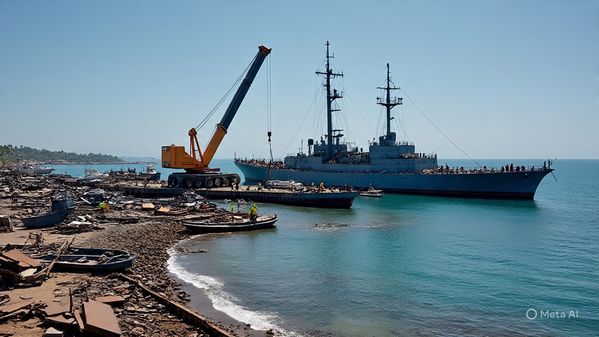USS Arizona Mooring Platform Removal: Respecting History While Protecting the Future
The still waters of Pearl Harbor hold stories that echo through the generations. Among them, the resting place of the USS Arizona is one of the most sacred. For over eight decades, the mooring platform beside this sunken battleship served as both a literal anchor and a symbolic bridge to the past. But in 2024, the decision to remove this mooring platform sparked thoughtful debate, meticulous planning, and a deeply emotional public response. The USS Arizona mooring platform removal is not merely an engineering effort—it’s a moment of national reflection.
In this article, we’ll explore the full story behind the platform’s removal: the history that led up to it, the reasoning behind the decision, the methods used to carry it out with dignity, and what it means for the preservation of one of America’s most hallowed memorials. Whether you’re a veteran, historian, visitor, or someone curious about how we balance preservation and progress, this is a chapter of U.S. history worth understanding in full.
The USS Arizona Memorial: A Sacred Site Rooted in Loss
The attack on Pearl Harbor on December 7, 1941, was one of the most pivotal and tragic days in American history. Of the 2,403 Americans killed, 1,177 were aboard the USS Arizona. The ship sank within minutes, entombing most of its crew. Today, the white memorial that spans the sunken hull stands as a solemn tribute, visited by more than 1.5 million people each year.
But few outside military and preservation circles have paid much attention to the mooring platform—a concrete dock built decades after the attack. It originally served a functional role but grew into a symbolic one, offering visitors access to the memorial from small boats. Over time, however, its presence became less essential—and more problematic.
Why Was the USS Arizona Mooring Platform Removed?
Deterioration and Safety Concerns
Time has not been kind to the mooring platform. Cracks, rust, and subsurface corrosion became increasingly visible. Structural assessments in 2022 and 2023 revealed that the platform posed a safety risk, not only to maintenance crews but also to the surrounding waters and the memorial itself. Its foundation was no longer stable, and there was concern about falling debris impacting the sunken vessel beneath.
Environmental Responsibility
The waters of Pearl Harbor are environmentally sensitive, and any manmade structure submerged in saltwater for decades carries risks. The U.S. National Park Service (NPS), which manages the memorial, in partnership with the U.S. Navy, raised environmental concerns tied to the platform’s degrading materials leaching into the harbor.
Removing the mooring platform was as much an environmental mitigation measure as it was a safety precaution. And it had to be done delicately—without disturbing the final resting place of hundreds of sailors.
Changing Visitor Logistics
Today, access to the USS Arizona Memorial is primarily via a floating dock connected to tour boats run by the U.S. Navy. The old mooring platform no longer served a logistical purpose. Instead, it stood as an aging remnant of earlier infrastructure that had become more symbolic than practical.
How the Removal Was Conducted: Engineering Meets Reverence
Removing a structure adjacent to a war grave is not the same as dismantling a typical pier. The Navy and NPS adopted a “surgical approach,” ensuring every aspect of the project was reviewed with respect and caution.
Step-by-Step Process
-
3D Scanning and Mapping
Before any physical action was taken, the mooring platform and surrounding area were scanned using sonar and 3D lidar imaging. This helped map the exact location of the structure in relation to the memorial and wreckage beneath. -
Manual Deconstruction Over Demolition
Instead of explosive or large-scale demolition, removal teams employed underwater diamond-wire cutting tools. These allowed for precise segmenting of the concrete platform into removable sections. -
Protective Barriers
Floating silt curtains and catchments were installed to prevent debris from escaping the immediate area. Every piece was lifted via crane and transferred to barges for responsible disposal and recycling. -
Cultural and Historical Oversight
Throughout the process, cultural monitors, including representatives from Native Hawaiian groups and WWII historians, were on-site to ensure spiritual and historical protocols were observed.
Public Reactions and Emotional Undercurrents
While the decision was ultimately supported by preservation authorities and military historians, public reactions were mixed.
-
Veterans’ Groups: Many World War II veteran organizations expressed support for the removal, noting that the platform’s deteriorating condition did not honor the memory of the fallen. Still, some expressed nostalgia and hoped some part of the platform could be preserved as a museum artifact.
-
Historians: Professional historians noted that while the platform was not original to the memorial, it had taken on a commemorative aura over time. Its removal sparked new conversations about what elements of historical sites we preserve and why.
-
Families of the Fallen: The families of those entombed aboard the Arizona were given early notice. Several shared statements emphasizing that the sanctity of the ship itself—not the infrastructure around it—was what mattered most.
What Comes Next: Redesigning with Respect
With the platform now gone, the NPS has plans to enhance the educational and interpretive experience around the memorial.
Upcoming Initiatives:
-
Virtual Exhibit of the Mooring Platform
A digital recreation of the mooring platform is expected to launch in late 2025. Visitors will be able to explore its construction, evolution, and removal through interactive displays at the Pearl Harbor Visitor Center. -
Underwater Preservation Grants
The funds saved from not rebuilding the platform are being redirected to ongoing corrosion monitoring and hull preservation of the USS Arizona itself. -
Augmented Reality Memorial Tours
Using AR headsets or mobile apps, visitors will be able to see historical overlays of the site as it appeared in different decades, including with the mooring platform in place.
Why This Matters: A Living History That Evolves
History isn’t frozen in time. It’s a living thread that we must protect, interpret, and—when necessary—carefully evolve. The USS Arizona mooring platform removal reflects a broader trend in historical preservation: the shift from static commemoration to dynamic, experience-driven engagement.
Preserving the integrity of sacred sites sometimes requires letting go of what no longer serves them. And in this case, by removing the platform with reverence and precision, we’ve taken a step forward in honoring the past without endangering the future.
Key Takeaways
-
The USS Arizona mooring platform, added decades after the attack, was removed in 2024 due to safety and environmental concerns.
-
The removal process involved state-of-the-art tools and was conducted with cultural and historical oversight.
-
Public reaction was respectful, though mixed, and led to new dialogues about preservation vs. modernization.
-
The site will now focus on immersive and educational experiences that honor the past while engaging future generations.
Frequently Asked Questions (FAQs)
Was the USS Arizona mooring platform part of the original memorial?
No. The mooring platform was constructed decades after the memorial’s completion and was used primarily for logistical access.
Is the USS Arizona Memorial itself being changed or moved?
Not at all. The memorial remains untouched and continues to be maintained with utmost care and respect.
What happens to the materials from the removed platform?
Most of the materials were recycled or disposed of responsibly. A few sections may be preserved for museum display or archival purposes.
Can I still visit the USS Arizona Memorial after the platform’s removal?
Yes. Visitor access is now managed via updated Navy-operated boat transfers and a modern floating dock system.
How did officials ensure the ship itself wasn’t damaged during removal?
Engineers used precision-cutting tools and real-time underwater monitoring to avoid any impact on the wreckage.
Why not just repair the old platform?
Structural assessments showed it was beyond cost-effective repair and posed safety and environmental risks.



